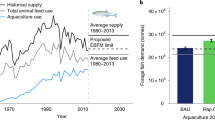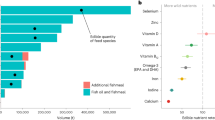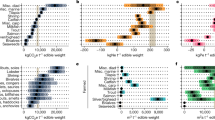Abstract
Aquaculture is supporting demand and surpassing wild-caught seafood. Yet, most fed aquaculture species (finfish and crustacea) rely on wild-captured forage fish for essential fatty acids and micronutrients, an important but limited resource. As the fastest growing food sector in the world, fed aquaculture demand will eventually surpass ecological supply of forage fish, but when and how best to avoid this ecological boundary is unclear. Using global production data, feed use trends, and human consumption patterns, we show how combined actions of fisheries reform, reduced feed use by non-carnivorous aquaculture and agricultural species, and greater consistent inclusion of fish by-products in China-based production can circumvent forage fish limits by mid-century. However, we also demonstrate that the efficacies of such actions are diminished if global diets shift to more seafood-heavy (that is, pescatarian) diets and are further constrained by possible ecosystem-based fisheries regulations in the future. Long-term, nutrient-equivalent alternative feed sources are essential for more rapid and certain aquaculture sustainability.
This is a preview of subscription content, access via your institution
Access options
Access Nature and 54 other Nature Portfolio journals
Get Nature+, our best-value online-access subscription
$29.99 / 30 days
cancel any time
Subscribe to this journal
Receive 12 digital issues and online access to articles
$119.00 per year
only $9.92 per issue
Buy this article
- Purchase on Springer Link
- Instant access to full article PDF
Prices may be subject to local taxes which are calculated during checkout



Similar content being viewed by others
References
The State of World Fisheries and Aquaculture 2016 (SOFIA) (FAO, 2016).
Martin, C. Not so many fish in the sea. Curr. Biol. 27, R439–R443 (2017).
Naylor, R. & Burke, M. Aquaculture and ocean resources: Raising tigers of the sea. Annu. Rev. Environ. Resour. 30, 185–218 (2005).
Troell, M. et al. Does aquaculture add resilience to the global food system? Proc. Natl Acad. Sci. USA 111, 13257–13263 (2014).
Tacon, A. G. J. & Metian, M. Feed matters: Satisfying the feed demand of aquaculture. Rev. Fish. Sci. Aquac. 23, 1–10 (2015).
Naylor, R. L. et al. Feeding aquaculture in an era of finite resources. Proc. Natl Acad. Sci. USA 106, 15103–15110 (2009).
Pikitch, E. K. et al. The global contribution of forage fish to marine fisheries and ecosystems. Fish Fish. 15, 43–64 (2014).
Koehn, L. E. et al. Developing a high taxonomic resolution food web model to assess the functional role of forage fish in the California Current ecosystem. Ecol. Model. 335, 87–100 (2016).
Alder, J., Campbell, B., Karpouzi, V., Kaschner, K. & Pauly, D. Forage fish: From ecosystems to markets. Annu. Rev. Environ. Resour. 33, 153–166 (2008).
Tacon, A. G. J. & Metian, M. Global overview on the use of fish meal and fish oil in industrially compounded aquafeeds: Trends and future prospects. Aquaculture 285, 146–158 (2008).
Tilman, D. & Clark, M. Global diets link environmental sustainability and human health. Nature 515, 518–522 (2014).
Machovina, B., Feeley, K. J. & Ripple, W. J. Biodiversity conservation: The key is reducing meat consumption. Sci. Total Environ. 536, 419–431 (2015).
Gephart, J. A. et al. The environmental cost of subsistence: Optimizing diets to minimize footprints. Sci. Total Environ. 553, 120–127 (2016).
Springmann, M., Godfray, H. C. J., Rayner, M. & Scarborough, P. Analysis and valuation of the health and climate change cobenefits of dietary change. Proc. Natl Acad. Sci. USA 113, 4146–4151 (2016).
Aleksandrowicz, L., Green, R., Joy, E. J. M., Smith, P. & Haines, A. The impacts of dietary change on greenhouse gas emissions, land use, water use, and health: A systematic review. PloS ONE 11, e0165797 (2016).
Smith, A. D. M. et al. Impacts of fishing low-trophic level species on marine ecosystems. Science 333, 1147–1150 (2011).
Pikitch, E. et al. Little Fish, Big Impact: Managing a Crucial Link in Ocean Food Webs (Lenfest Ocean Program, 2012).
Kristofersson, D. & Anderson, J. L. Is there a relationship between fisheries and farming? Interdependence of fisheries, animal production and aquaculture. Mar. Policy 30, 721–725 (2006).
Shepherd, C. J. & Jackson, A. J. Global fishmeal and fish-oil supply: Inputs, outputs and markets. J. Fish. Biol. 83, 1046–1066 (2013).
Fish to 2030: Prospects for Fisheries and Aquaculture (World Bank, 2013).
Watson, R. A. et al. Marine foods sourced from farther as their use of global ocean primary production increases. Nat. Commun. 6, 7365 (2015).
Merino, G. et al. Can marine fisheries and aquaculture meet fish demand from a growing human population in a changing climate? Glob. Environ. Change 22, 795–806 (2012).
Essington, T. E. et al. Fishing amplifies forage fish population collapses. Proc. Natl Acad. Sci. USA 112, 6648–6652 (2015).
Chiu, A. et al. Feed and fishmeal use in the production of carp and tilapia in China. Aquaculture 414, 127–134 (2013).
Bimbo, A. P. & Crowther, J. B. Fish meal and oil: Current uses. J. Am. Oil Chem. Soc. 69, 221–227 (1992).
Olsen, R. L., Toppe, J. & Karunasagar, I. Challenges and realistic opportunities in the use of by-products from processing of fish and shellfish. Trends Food Sci. Technol. 36, 144–151 (2014).
Sarker, P. K. et al. Towards sustainable aquafeeds: Complete substitution of fish oil with marine microalga Schizochytrium sp. improves growth and fatty acid deposition in juvenile Nile tilapia (Oreochromis niloticus). PloS ONE 11, e0156684 (2016).
Olsen, R. L. & Hasan, M. R. A limited supply of fishmeal: Impact on future increases in global aquaculture production. Trends Food Sci. Technol. 27, 120–128 (2012).
Olson, J., Clay, P. M. & Pinto da Silva, P. Putting the seafood in sustainable food systems. Mar. Policy 43, 104–111 (2014).
Cao, L. et al. China’s aquaculture and the world’s wild fisheries. Science 347, 133–135 (2015).
Mo, W. Y., Man, Y. B. & Wong, M. H. Use of food waste, fish waste and food processing waste for China’s aquaculture industry: Needs and challenge. Sci. Total Environ. 613–614, 635–643 (2018).
Waite, R. et al. Improving Productivity and Environmental Performance of Aquaculture (WRI, 2014).
Lindegren, M., Checkley, D. M., Rouyer, T., MacCall, A. D. & Stenseth, N. C. Climate, fishing, and fluctuations of sardine and anchovy in the California Current. Proc. Natl Acad. Sci. USA 110, 13672–13677 (2013).
Tacon, A. G. J. & Metian, M. Fish matters: Importance of aquatic foods in human nutrition and global food supply. Rev. Fish. Sci. 21, 22–38 (2013).
Plagányi, É. E. & Essington, T. E. When the SURFs up, forage fish are key. Fish. Res. 159, 68–74 (2014).
Cury, P. M. et al. Global seabird response to forage fish depletion—One-third for the birds. Science 334, 1703–1706 (2011).
Szuwalski, C. S., Burgess, M. G., Costello, C. & Gaines, S. D. High fishery catches through trophic cascades in China. Proc. Natl Acad. Sci. USA 114, 717–721 (2017).
Checkley, D., Alheit, J., Oozeki, Y. & Roy, C. Climate Change and Small Pelagic Fish (Cambridge Univ. Press, Cambridge, 2009).
Barange, M. et al. Impacts of climate change on marine ecosystem production in societies dependent on fisheries. Nat. Clim. Change 4, 211–216 (2014).
Cheung, W. W. L., Watson, R. & Pauly, D. Signature of ocean warming in global fisheries catch. Nature 497, 365–368 (2013).
Laufkötter, C. et al. Drivers and uncertainties of future global marine primary production in marine ecosystem models. Biogeosciences 12, 6955–6984 (2015).
Tacon, A. & Metian, M. G. J. T. M. Fishing for feed or fishing for food: Increasing global competition for small pelagic forage fish. AMBIO 38, 294–302 (2009).
Cashion, T., Le Manach, F., Zeller, D. & Pauly, D. Most fish destined for fishmeal production are food-grade fish. Fish Fish. 8, 837–844 (2017).
Isaacs, M. The humble sardine (small pelagics): Fish as food or fodder. Agric. Food Secur. 5, 27 (2016).
Olsen, Y. Resources for fish feed in future mariculture. Aquac. Environ. Interact. 1, 187–200 (2011).
Froese, R. & Pauly, D. (eds) FishBase (2018); www.fishbase.org.
Martell, S. & Froese, R. A simple method for estimating MSY from catch and resilience. Fish Fish. 14, 504–514 (2013).
Tolkamp, B., Wall, E., Roehe, R., Newbold, J. & Zaralis, K. Review of Nutrient Efficiency in Different Breeds of Farm Livestock (UK Department for Environment, Food and Rural Affairs, 2010).
Wilkinson, J. M. Re-defining efficiency of feed use by livestock. Animal 5, 1014–1022 (2011).
The State of Food and Agriculture 2016: Climate Change, Agriculture, and Food Security (FAO, 2016).
FAOSTAT Database Collections (FAO, 2013).
Alexandratos, N. & Bruinsma, J. World Agriculture Towards 2030/2050: The 2012 Revision (ESA Rome, FAO, 2012).
Hunter, M. C., Smith, R. G., Schipanski, M. E., Atwood, L. W. & Mortensen, D. A. Agriculture in 2050: Recalibrating targets for sustainable intensification. BioScience 67, 386–391 (2017).
RCoreTeam R: A Language and Environment for Statistical Computing (R Foundation for Statistical Computing, 2017).
Index Mundi (International Fish Meal and Fish Oil Organization, 2017).
Acknowledgements
This research and H.E.F. were supported by the Science for Nature and People Partnership, a partnership of The Nature Conservancy, the Wildlife Conservation Society and the National Center for Ecological Analysis and Synthesis (SNP015). N.S.J. was supported by VILLUM FONDEN (grant VKR023371). T.C. acknowledges support by the Waitt Foundation.
Author information
Authors and Affiliations
Contributions
H.E.F. conceived the initial study. H.E.F., N.S.J. and T.E.E. developed the research and methodology with critical input and insight from T.C. and B.S.H. H.E.F. and N.S.J. collected and analysed the data. All authors interpreted the results and implications. H.E.F. and N.S.J. made the figures. H.E.F. drafted the manuscript with significant input and revisions from all authors.
Corresponding author
Ethics declarations
Competing interests
The authors declare no competing interests
Additional information
Publisher’s note: Springer Nature remains neutral with regard to jurisdictional claims in published maps and institutional affiliations.
Supplementary information
Supplementary Information
Supplementary Methods, Supplementary Tables 1,2, Supplementary Figs 1–4, Supplementary References 1–8
Rights and permissions
About this article
Cite this article
Froehlich, H.E., Jacobsen, N.S., Essington, T.E. et al. Avoiding the ecological limits of forage fish for fed aquaculture. Nat Sustain 1, 298–303 (2018). https://doi.org/10.1038/s41893-018-0077-1
Received:
Accepted:
Published:
Issue Date:
DOI: https://doi.org/10.1038/s41893-018-0077-1
This article is cited by
-
Optimal DL-methionyl-DL-methionine supplementation in a plant-protein diet for the red swamp crayfish Procambarus clarkii
Aquaculture International (2023)
-
Controlling the nitrogen environment for optimal Rhodomonas salina production
Journal of Applied Phycology (2023)
-
Tenebrio molitor larvae meal inclusion affects hepatic proteome and apoptosis and/or autophagy of three farmed fish species
Scientific Reports (2022)
-
The environmental footprint of global food production
Nature Sustainability (2022)
-
Expanding ocean food production under climate change
Nature (2022)



